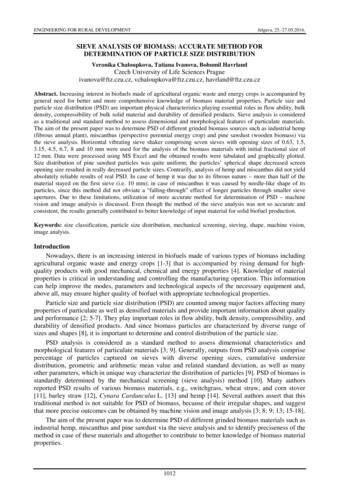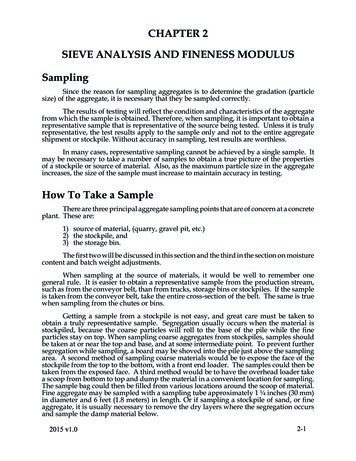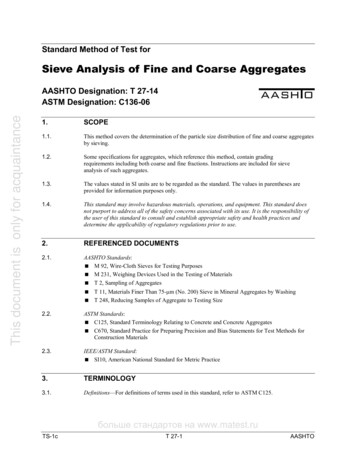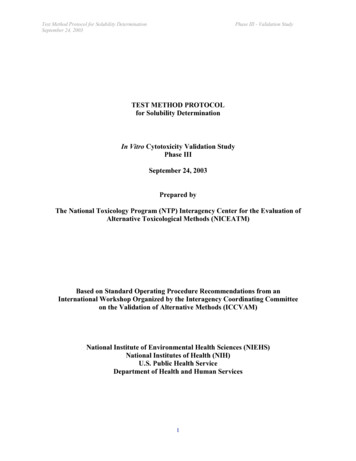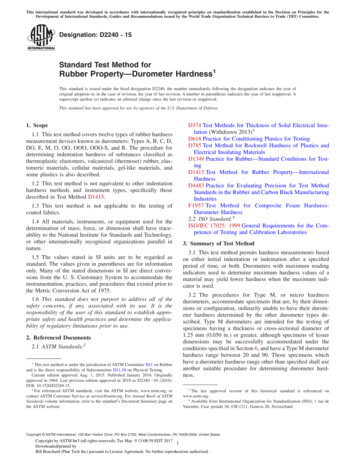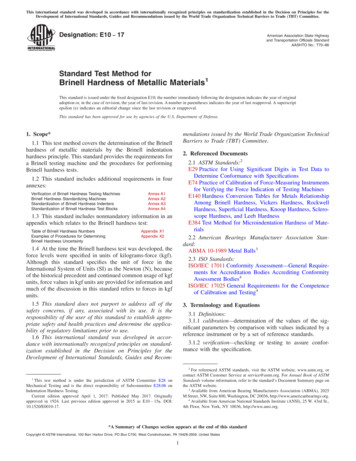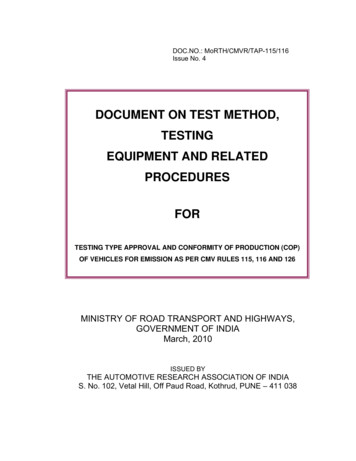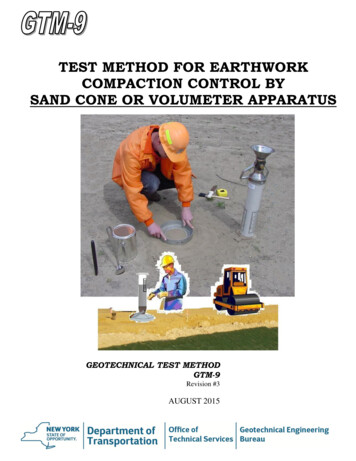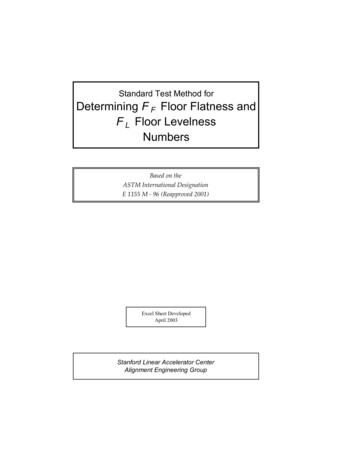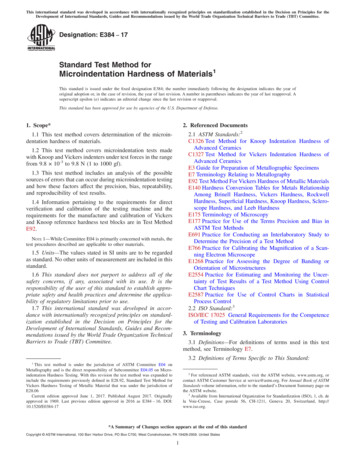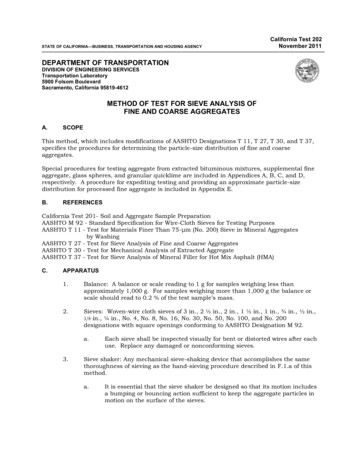
Transcription
STATE OF CALIFORNIA—BUSINESS, TRANSPORTATION AND HOUSING AGENCYCalifornia Test 202November 2011DEPARTMENT OF TRANSPORTATIONDIVISION OF ENGINEERING SERVICESTransportation Laboratory5900 Folsom BoulevardSacramento, California 95819-4612METHOD OF TEST FOR SIEVE ANALYSIS OFFINE AND COARSE AGGREGATESA.SCOPEThis method, which includes modifications of AASHTO Designations T 11, T 27, T 30, and T 37,specifies the procedures for determining the particle-size distribution of fine and coarseaggregates.Special procedures for testing aggregate from extracted bituminous mixtures, supplemental fineaggregate, glass spheres, and granular quicklime are included in Appendices A, B, C, and D,respectively. A procedure for expediting testing and providing an approximate particle-sizedistribution for processed fine aggregate is included in Appendix E.B.REFERENCESCalifornia Test 201- Soil and Aggregate Sample PreparationAASHTO M 92 - Standard Specification for Wire-Cloth Sieves for Testing PurposesAASHTO T 11 - Test for Materials Finer Than 75-μm (No. 200) Sieve in Mineral Aggregatesby WashingAASHTO T 27 - Test for Sieve Analysis of Fine and Coarse AggregatesAASHTO T 30 - Test for Mechanical Analysis of Extracted AggregateAASHTO T 37 - Test for Sieve Analysis of Mineral Filler for Hot Mix Asphalt (HMA)C.APPARATUS1.Balance: A balance or scale reading to 1 g for samples weighing less thanapproximately 1,000 g. For samples weighing more than 1,000 g the balance orscale should read to 0.2 % of the test sample’s mass.2.Sieves: Woven-wire cloth sieves of 3 in., 2 ½ in., 2 in., 1 ½ in., 1 in., ¾ in., ½ in.,3/8 in., ¼ in., No. 4, No. 8, No. 16, No. 30, No. 50, No. 100, and No. 200designations with square openings conforming to AASHTO Designation M 92.a.3.Each sieve shall be inspected visually for bent or distorted wires after eachuse. Replace any damaged or nonconforming sieves.Sieve shaker: Any mechanical sieve-shaking device that accomplishes the samethoroughness of sieving as the hand-sieving procedure described in F.1.a of thismethod.a.It is essential that the sieve shaker be designed so that its motion includesa bumping or bouncing action sufficient to keep the aggregate particles inmotion on the surface of the sieves.
California Test 202November 2011b.D.Refer to Section F.1.b of this method for procedures to verify shakerefficiency.4.Agitator (Figure 1): A mechanical device designed to hold the wash vessel in anupright position while subjecting it to a lateral reciprocating motion at a rate of285 10 complete cycles per minute. The reciprocating motion shall be producedby means of an eccentric located in the base of the carrier, and the length of thestroke shall be 1.75 in. 0.025 in. The clearance between the cam and follower ofthe eccentric shall be between 0.001 in. and 0.004 in. Other types of agitators maybe used provided the length of time and other factors are adjusted to produce thesame results as those obtained using the agitator described above.5.A combination sieve shaker-agitator is allowable when it meets the aboverequirements for shaking (3.a & b) while in the shaking mode and agitation (4)while in the agitation mode. A Tyler portable sieve shaker meets the aboverequirements when modified according to TL drawing No. D536.6.Mechanical Washing Vessel: A flat-bottom, straight-sided, cylindrical vesselconforming to the specifications and dimensions shown in Figure 2.7.An oven or other suitable thermo-statically controlled heating device capable ofmaintaining a temperature of 230 F 9 F.MATERIALSDistilled, deionized, or good-quality tap water shall be used for washing the fine-aggregate testsample.E.SIZE OF SAMPLE1.The sample to be tested shall be of sufficient size to ensure representation of thematerial. The exact amount of material required will vary according to the nominalsize of the aggregate and the particle-size distribution.2.Recommended sample mass for each aggregate size of processed aggregates (suchas sized aggregates for PCC and AC) or composite aggregates (such as AB and CTB)that are comprised of approximately 40 % or more of aggregate retained on the No.4 sieve, are listed in Table 1.TABLE 1RecommendedMass of PortionRetained onNo. 4 SieveMaximumNominalAggregate SizeOver 2 ½ in.2 ½ in.2 in.1 ½ in.1 in.3/4 in.½ in.3/8 1,000 g2
California Test 202November 20113.4.F.Sample size, for materials not adaptable to the recommendations in paragraph 2,should be sufficient to yield the amounts noted below for each coarse-size fractionthat makes up 5 % or more of the total sample.a.At least 1,000 g of coarse-size fractions equal to or larger than ¾ in.b.At least 500 g of coarse-size fractions smaller than ¾ in.Samples containing more than 15 % passing the No. 4 sieve shall be of sufficientsize to yield at least 1,000 g of material passing the No. 4 sieve.SIEVING PROCEDURE1.Separate the test sample into a series of sizes using such sieves as are necessary todetermine compliance with the specifications for the material being tested. Eitherthe hand or mechanical sieving method may be used.a.Perform the hand method of sieving by means of a lateral and verticalmotion of the sieve, accompanied by a jarring action, so as to keep thesample moving continuously over the surface of the sieve. Do not turn ormanipulate particles through the sieve by hand. Continue sieving until notmore than 0.5 % by mass of the total sample will pass any sieve during oneadditional minute of hand sieving.b.Mechanical sieving may be used only after it has been demonstrated thatthe shaker will separate a test sample with the same effectiveness as thehand method. The effectiveness of the mechanical shaker and theminimum shaking time shall be determined for each shaker by comparisonwith the hand-sieving method using the procedure described below.(1)Obtain a test sample of all crushed, clean, durable aggregate with arelatively uniform size distribution over the range of sieves to beincluded.(2)Determine the total mass of the test sample and the tare mass ofeach sieve.(3)Separate the sample into its various sieve sizes using themechanical shaker operated for a trial period.(4)At the end of the trial period, determine the amount of materialretained on each sieve by weighing the sieves and retained materialand subtracting the mass of the sieve.(5)Reassemble the sieves in the mechanical shaker, and shake for anadditional period of time of not less than 1 min.(6)Determine the amount of material on each sieve as in step (4).(7)Repeat steps (4) through (6) until not more than 0.5 % by mass ofthe total sample passes through any of the sieves during theadditional shaking time.(8)Sieve each size fraction for one additional minute using the handsieving procedure.3
California Test 202November 2011(9)If more than 0.5 % by mass of the total sample passes through anysieve during the hand sieving, the mechanical shaker is notperforming effectively, and it shall not be used.(10)The required shaking time for the shaker shall be at least 125 % ofthe minimum time required to accomplish the thoroughness ofsieving described above. In no case shall the shaking time for anyshaker be less than 5 min.c.When sieving, limit the amount of material retained on the No. 4 andcoarser sieves to a single layer of aggregate. If necessary, sieve the testsample in portions; then combine all respective portions retained on thesieves before weighing.d.In no case, when sieving fine aggregate (material passing the No. 4 sieve),shall the material retained on any sieve at the completion of the sievingoperation exceed that mass specified in Table 2. To reduce the amount ofmaterial retained on a sieve, either use a sieve with openings slightly largerthan the overloaded sieve, or split the entire sample into smaller portionsprior to sieving, and then combine respective fractions prior to weighing.TABLE 2MAXIMUM MASS IN GRAMS OF MATERIAL ALLOWED ON SIEVE* AT COMPLETIONOF SIEVING OPERATIONSieveSizeNo. 8163050100200Wt. Per sq.in.4.03.02.52.01.51.0TotalMass for8 in.DiameterSieve2001501251007550*For intermediate sieve sizes not listed in this table, the mass specified for the next smaller sieve size shallapply.G.DETERMINATION OF COARSE-AGGREGATE PARTICLE-SIZE DISTRIBUTION1.Prepare all materials as prescribed in California Test 201. Be sure to clean allcoatings from the coarse aggregate and break clods sufficiently to pass the No. 4sieve.2.If the coarse-aggregate particles contained in a sample are clean or are coated lightlywith fines, which can be removed easily by sieving, it will not be necessary tosubject the coarse portion to a cleaning process prior to performing the coarse-sieveseparation.3.Separate the sample on the following sieves: 3 in., 2½ in., 2 in., 1½ in., 1 in., ¾ in.,3/8 in., and No. 4. Other sieves may be added as required to determine compliancewith specifications or to reduce the amount of material retained on certain sieves.It is permissible to include the No. 8 sieve with the coarse-sieve separation when itis not necessary to determine the distribution of material finer than the No. 8 sieve.4
California Test 202November 20114.5.H.Place each coarse-size fraction in a separate container.a.When a sample has been divided into two or more portions to facilitatesieving, recombine all portions of the same size.b.Combine all portions of the material passing the No. 4 sieve obtained fromthe sample preparation and sieving phases.Determine the total mass of material retained on each coarse sieve and the totalamount of fine material passing the No. 4 sieve. The total mass retained on a givensieve is the sum of the material retained on the sieve plus the material retained onall larger sieves.a.Accumulate the mass of material retained on each successive sievebeginning with the coarsest size.b.When it is not necessary to keep the aggregate’s size fractions separated,the sized portions may be combined in succession, and the accumulatedmass may be determined directly.DETERMINATION OF THE FINE-AGGREGATE PARTICLE-SIZE DISTRIBUTION1.Sieve the entire test sample according to Section F.2.Split or quarter a fine-aggregate test sample weighing 500 g 25 g from thematerial passing the No. 4 sieve.3.4.a.If there is insufficient material passing the No. 4 sieve to obtain the required500 g 25 g, use all of the material passing the No. 4 sieve for the fineaggregate test sample.b.If less than 10 % of the submitted sample is retained on the No. 30 sieve, itis permissible to reduce the fine-aggregate test sample’s mass toapproximately 125 g. Obtain this smaller test sample by carefully splittingthe prepared 500 g portion into four quarters. Do not make anyadjustments for mass during this splitting operation.Oven dry the fine-aggregate test sample to constant mass at a temperature of230 F 9 F, and then cool it to room temperature. Weigh and record the mass ofoven-dried material as the test sample’s mass.a.Oven-drying the test sample prior to washing may be eliminated providedthe moisture content is determined by drying a duplicate sample and themass is corrected to establish the dry mass of the test sample.b.When testing reclaimed aggregates containing traces of asphalt or asphaltconcrete, the oven-drying temperature shall not exceed 100 F.Place the fine-aggregate test sample in the mechanical washing vessel, add1000 mL 5 mL of water, and clamp the lid in place. Secure the vessel in themechanical agitator. After 10 min 30 s have elapsed from the introduction of thewash water, agitate the vessel and contents for 2 min 5 s.5
California Test 202November 20115.Following agitation, remove the vessel from the shaker, unclamp the lid, and pourthe contents into a No. 200 sieve. Rinse any remaining fines from the vessel intothe sieve. Direct water from a flexible hose attached to a faucet onto the sampleuntil the water passing through the sieve comes out clear. It may be necessary toflood clayey or silty samples while it is still in the vessel to prevent clogging the No.200 sieve. Repeated flooding may be necessary before all of the contents can bepoured from the vessel into the sieve.6.After rinsing, wash the material from the sieve into a drying pan; then place thedrying pan in a slanting position until the free water that drains to the lower edgeis clear. Pour this water off taking care not to lose any material from the testsample.7.Oven-dry the washed test sample to constant mass at a temperature of 230 F 9 Fand cool it to room temperature. Spreading the sample as thin as possible in large,shallow drying pans will decrease the drying time.a.I.When testing reclaimed aggregate containing traces of asphalt concrete, theoven-drying temperature shall not exceed 100 F.8.Separate the sample on the Nos. 8, 16, 30, 50, 100, and 200 sieves. Other sievesmay be added as required to determine compliance with specifications or to reducethe amount of material retained on certain sieves.9.Determine and record the mass of material retained on each sieve. The followingprocedure normally is used for the fine-aggregate test sample.a.Weigh the material retained on the coarsest sieve, and record this mass onthe appropriate work card. Do not remove the material from the scale orbalance.b.Add the material retained on the next finer sieve, and record this mass onthe appropriate work card. Do not remove the material from the scale orbalance.c.Continue accumulating mass until the material in the sieve pan is weighed.CALCULATIONS1.Convert mass to percentages as follows:a.Compute the percentage of material retained on each sieve by the followingformula:R 100 Mc/MtR Percentage of test sample retained on the sieve.Mc Cumulative mass of material retained on the sieve.Mt Oven-dried mass of test sample prior to washing.Where:6
California Test 202November 2011b.Compute the percentage of material passing each sieve as follows:P 100 – RP Percentage of test sample passing the sieve.R Percent
AASHTO T 37 - Test for Sieve Analysis of Mineral Filler for Hot Mix Asphalt (HMA) C. APPARATUS 1. Balance: A balance or scale reading to 1 g for samples weighing less than approximately 1,000 g. For samples weighing more than 1,000 g the balance or scale should read to 0.2 % of the test sample’s mass. 2. Sieves: Woven-wire cloth sieves of 3 in., 2 ½ in., 2 in., 1 ½ in., 1 in., ¾ in., ½ .
